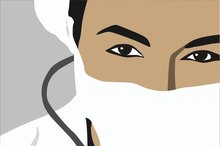How Men Get Tested for STDs
Women get tested for sexually transmitted diseases (STDs) by having blood tests, pap smears and pelvic exams. For men, STD exams involve both blood tests and swabbing of the penis. STD exams for men are considered extremely accurate, and screen for syphilis, gonorrhea and chlamydia, genital herpes and HIV.
If you are experiencing serious medical symptoms, seek emergency treatment immediately.
Tests for Syphilis
Often, the first STD screening men undergo is a syphilis screening exam. The doctor will both visually examine the genital area (looking for a sore called a chancre on the penis, rectum or mouth), and also feel the neck for swollen lymph nodes. Depending on how long the doctor suspects the patient may have had syphilis, he also does a blood test (which screens for syphilis-specific antibodies) and checks the patient for rashes, warts, fever, muscle aches and other flu-like symptoms.
Gonorrhea/Chlamydia Test
What Are the Treatments for Positive HPV & ASCUS?
Learn More
Since gonorrhea and chlamydia are similar STDs, they are screened using the same tests. First, the doctor will ask the patient if he has burning with urination or unusual discharge from the penis, which are key symptoms for both STDs. Then, the doctor will either insert a cotton swab up the urethra (the urination hole on the penis) to collect a urine sample, or have the patient urinate in a cup. The urine sample is sent to a pathology lab, where pathologists check for antibodies. If there are gonorrhea or chlamydia-specific antibodies, the test is positive.
Genital Herpes Test
Genital herpes are easy to diagnose when there are symptoms, though these symptoms may not always occur immediately after the initial infection. The symptoms include genital warts, blisters and sores. Abnormal discharge from the penis is another symptom. These lesions are usually painful because they are filled with bacteria. To definitively test for herpes, the doctor will insert a swab into one of the sores to collect a bacteria sample. The doctor may also collect discharge from the penis. The doctor then sends the samples to a pathology lab, where pathologists do a culture test, in which the sample is placed in an area where it may grow. If it grows, the sample contains the HSV virus that causes genital herpes, which means the test is positive for herpes.
HIV Test
Side Effects of Gonorrhea
Learn More
As with other STD tests, the HIV exam tests for antibodies in the blood and body fluids. During an HIV test, a doctor will do an EIA (enzyme immunoassay) test that involves drawing blood and checking the blood sample for antibodies under a microscope. If the EIA test is positive, the pathologist then does a western blot exam, which involves placing proteins from the blood or oral fluid on a test strip. The pathologist then adds a special gel to the test strip that stimulates the antibody reactions specific to HIV. If these reactions occur, then the test is positive for HIV.
Related Articles
Resources
Writer Bio
Writer/editor







